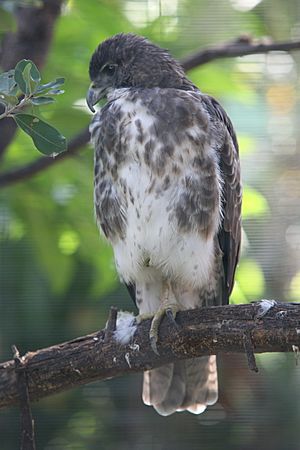Hawaiian hawk facts for kids
Quick facts for kids Hawaiian hawk |
|
|---|---|
 |
|
| A Hawaiian hawk at the Honolulu Zoo | |
| Conservation status | |
| Scientific classification | |
| Genus: |
Buteo
|
| Species: |
solitarius
|
The Hawaiian hawk, also called the ʻio (pronounced "ee-oh"), is a special type of raptor. It belongs to the Buteo group of hawks. This bird is endemic to Hawaiʻi, which means it's found nowhere else in the world!
Today, the ʻio lives only on the Big Island of Hawaiʻi. It likes to nest in native ʻōhiʻa lehua (Metrosideros polymorpha) trees. Long ago, fossils show that these hawks also lived on other Hawaiian islands like Molokaʻi, Oʻahu, and Kauaʻi. The ʻio is one of only two native birds of prey in Hawaiʻi; the other is the Pueo, which is a Hawaiian short-eared owl.
For a while, the Hawaiian hawk was listed as an endangered species in the United States. This meant it had special protection. However, in 2020, it was removed from this list. Even so, the IUCN still considers the ʻio to be a "Near Threatened" species. This means it could become endangered again if we don't protect its home.
Contents
What Does the Hawaiian Hawk Look Like?
The Hawaiian hawk is about 40 to 46 centimeters (16 to 18 inches) long. Female hawks are usually bigger than males. A female weighs about 605 grams (21.3 ounces), while a male weighs around 441 grams (15.6 ounces).
These hawks come in two main color types:
- Dark phase: These hawks have dark brown heads, chests, and underwings.
- Light phase: These hawks have dark heads, but their chests and underwings are light-colored.
Adult hawks have yellowish feet and legs. Young hawks have greenish feet and legs. During the time they lay eggs, one of the parent hawks (probably the female) gets a bright yellow spot just above its beak.
Threats to the Hawaiian Hawk
The ʻio faces several dangers that can harm its population. Some of these threats include:
- Illegal shootings: People sometimes shoot these birds even though it's against the law.
- Habitat loss: Their native forest homes are being damaged or disappearing.
- Poisoning: They can get sick or die from poisons meant for other animals.
- Vehicle collisions: Hawks can get hit by cars.
- Starvation: Sometimes they can't find enough food.
- Predation: Other animals might hunt them.
Hawaiian Hawk Lifestyle and Reproduction
The Hawaiian hawk is a solitary bird. This means it usually stays by itself and protects its territory all year long.
Nesting and Chicks
Hawks build their nests and lay eggs from March through September. They usually lay only one egg, but sometimes they can lay up to three. The female hawk does most of the sitting on the eggs for about 38 days. Meanwhile, the male hawk does most of the hunting to find food.
After the egg hatches, the female hawk is very protective. She only lets the male hawk come near the nest when he brings food. The baby hawk, called a chick, is ready to fledge (fly for the first time) when it is about seven or eight weeks old. About 50 to 70 percent of nests successfully raise young hawks.
Hunting and Diet
The ʻio often hunts by sitting still and watching for prey. But it can also dive down from the sky to catch its food. Since Hawaiʻi has very few native land mammals (the Hawaiian Hoary bat is the only one), the ʻio's original diet was probably mostly smaller birds. These birds included flightless ducks and rails that used to live in Hawaiʻi.
Today, the Hawaiian hawk mostly eats animals that were brought to the islands. These include rats, lizards, and game birds. They also eat insects and other small creatures. They are very good at finding food and can eat many different things. They have even been known to hunt the Hawaiian crow, a bird that is now extinct in the wild.
Calls and Flight
The ʻio has a loud, high-pitched call that sounds a lot like its Hawaiian name: "eeeh-oh!" They are especially noisy during the breeding season. These hawks are also known to be strong fliers.
Cultural Importance
The Hawaiian hawk was a very important symbol in old Hawaiian legends. It was sometimes called “ʻiolani,” which means “exalted hawk” or “royal hawk.” This name was also used for Kamehameha IV, a Hawaiian king, and for the famous ʻIolani Palace.
See also
 In Spanish: Busardo hawaiano para niños
In Spanish: Busardo hawaiano para niños


